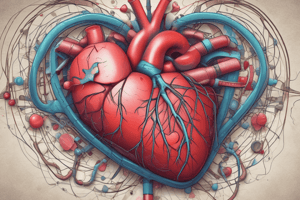Podcast
Questions and Answers
Which of the following is a risk factor for atrial fibrillation?
Which of the following is a risk factor for atrial fibrillation?
- Vegetarian diet
- Hypertension (correct)
- Regular exercise
- Low cholesterol levels
What is the most appropriate management for a patient with hemodynamically unstable atrial fibrillation?
What is the most appropriate management for a patient with hemodynamically unstable atrial fibrillation?
- Observation
- Synchronized cardioversion (correct)
- Pharmacological agents optimization
- Unsynchronized cardioversion (defibrillation)
Which of the following best describes ventricular fibrillation?
Which of the following best describes ventricular fibrillation?
- Rapidly irregular electrical activity with marked variability in ECG waveform, usually > 300 beats/min (correct)
- A state of cardiac electrical instability defined by ≥3 episodes of sustained VT or VF
- Sudden cessation of cardiac activity such that the patient becomes unresponsive
- Cardiac arrhythmia of ≥3 consecutive complexes originating in the ventricles at a rate >100 beats/min
Which term refers to a state of cardiac electrical instability defined by ≥3 episodes of sustained ventricular tachycardia or ventricular fibrillation?
Which term refers to a state of cardiac electrical instability defined by ≥3 episodes of sustained ventricular tachycardia or ventricular fibrillation?
Which medication is classified as a Class III antiarrhythmic agent?
Which medication is classified as a Class III antiarrhythmic agent?
What is the initial dosing of lidocaine for intravenous administration?
What is the initial dosing of lidocaine for intravenous administration?
What is the recommended monitoring parameter for patients receiving procainamide?
What is the recommended monitoring parameter for patients receiving procainamide?
Which of the following is a risk factor for ventricular arrhythmias?
Which of the following is a risk factor for ventricular arrhythmias?
What is the most appropriate management for a patient eating breakfast and talking to the nurse, with an ECG demonstrating ventricular tachycardia?
What is the most appropriate management for a patient eating breakfast and talking to the nurse, with an ECG demonstrating ventricular tachycardia?
What does defibrillation involve?
What does defibrillation involve?
What best describes sudden cardiac death?
What best describes sudden cardiac death?
What is the most appropriate management for unstable atrial fibrillation?
What is the most appropriate management for unstable atrial fibrillation?
What is a potential side effect of Mexiletine toxicity?
What is a potential side effect of Mexiletine toxicity?
What is a monitoring parameter for patients on Mexiletine?
What is a monitoring parameter for patients on Mexiletine?
Which class of drugs does Amiodarone belong to?
Which class of drugs does Amiodarone belong to?
What is a potential adverse effect of Amiodarone?
What is a potential adverse effect of Amiodarone?
Which medication is a nonselective ß-blocker?
Which medication is a nonselective ß-blocker?
Which syndrome is associated with an increased risk for ventricular arrhythmias and sudden cardiac death?
Which syndrome is associated with an increased risk for ventricular arrhythmias and sudden cardiac death?
What is the recommended action for managing Long QT Syndrome?
What is the recommended action for managing Long QT Syndrome?
Which antimicrobial agents are known to prolong the QTc interval?
Which antimicrobial agents are known to prolong the QTc interval?
What is the initial dosing of adenosine for intravenous push?
What is the initial dosing of adenosine for intravenous push?
Which type of arrhythmia is characterized by irregularly fast heart rate?
Which type of arrhythmia is characterized by irregularly fast heart rate?
What is the recommended second dose of adenosine for intravenous push?
What is the recommended second dose of adenosine for intravenous push?
Which medication class does adenosine belong to?
Which medication class does adenosine belong to?
What is the half-life (t1/2) of adenosine?
What is the half-life (t1/2) of adenosine?
Which nonpharmacologic treatment involves a technique called Valsalva Maneuvers?
Which nonpharmacologic treatment involves a technique called Valsalva Maneuvers?
Which of the following is a potential risk factor that should be assessed in the evaluation of patients with arrhythmias?
Which of the following is a potential risk factor that should be assessed in the evaluation of patients with arrhythmias?
What is the main characteristic of supraventricular tachycardia?
What is the main characteristic of supraventricular tachycardia?
What is the recommended initial dose for adenosine in the pharmacologic treatment of arrhythmias?
What is the recommended initial dose for adenosine in the pharmacologic treatment of arrhythmias?
What is the half-life of adenosine that must be considered when administering the medication?
What is the half-life of adenosine that must be considered when administering the medication?
Which maneuver is a nonpharmacologic treatment option for certain arrhythmias?
Which maneuver is a nonpharmacologic treatment option for certain arrhythmias?
According to the 2023 ACC/AHA/ACCP/HRS Guideline, which type of arrhythmia is characterized by irregularly fast heart rate?
According to the 2023 ACC/AHA/ACCP/HRS Guideline, which type of arrhythmia is characterized by irregularly fast heart rate?
Flashcards are hidden until you start studying



